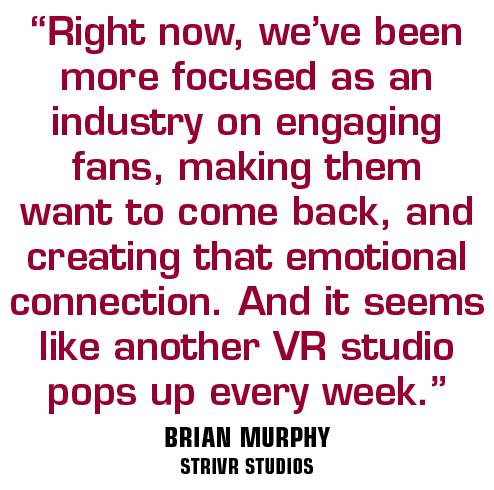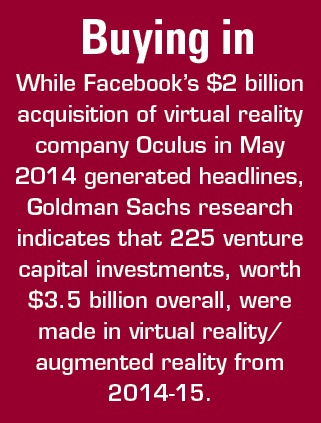Billions of dollars are pouring into virtual reality, with new funding deals arriving almost by the week. Nearly every major league commissioner, team owner and network head is keenly interested, if not already active, in the space. The technology is quickly morphing to numerous facets of the fan experience apart from live or on-demand broadcasts.
Yet for all that energy and exuberance around virtual reality, there exists very little in the way of a traditional business ecosystem around the technology.
Deals to produce virtual reality broadcasts or fan installations are still generally done as one-offs without any sort of
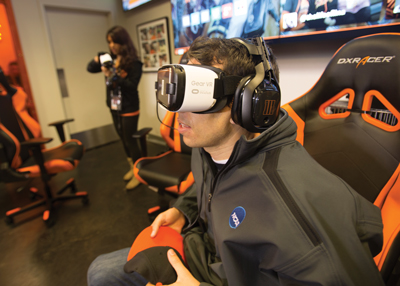 |
The San Francisco Giants recently debuted a virtual reality experience at AT&T Park in partnership with Jaunt.
Photo by: San Francisco Giants |
formal request for proposals. Rival virtual reality firms compete for new business essentially in name only, with most outfits awash in more activity than they can fully handle at current staffing levels. And the primary goal for most firms remains to grow the nascent technology rather than steal market share or engage in price wars.
“The market is just not mature enough yet for an RFP,” said Randy Eccker, Circle Media chairman and chief executive, and a director of California-based virtual reality firm Voke. “Everybody is still defining what we all are in this space, and we still have to teach a lot of people how to do VR, essentially.”
That definition, however, is coming quickly. Goldman Sachs recently projected the global virtual reality market will grow to $80 billion by 2025 from essentially nothing a few short years ago, and perhaps approaching $200 billion in a more aggressive scenario. Such numbers stand much higher than the current hardware markets for desktop computers or gaming consoles.
Getting to those numbers will require not only creating mass consumer adoption for virtual reality, but establishing a marketplace itself in which businesses compete for things such as content rights, facility contracts and team relationships. How that marketplace emerges will speak volumes on whether virtual reality becomes a fully established standard of the industry, similar to high-definition TV, or more of a quickly passing fad such as the ill-fated 3-D.
“There does need to be more of a conversation in our space around [return on investment],” said Brian Murphy, co-managing partner of Strivr Studios, a division of prominent virtual reality company Strivr. “I do think VR is headed in that direction. Right now, we’ve been more focused as an industry on engaging fans, making them want to come back, and creating that emotional connection. And it seems like another VR studio pops up every week.”
Sticking to their lanes
The early formation of a more mature virtual reality marketplace has been marked by a splintering of core competencies into several distinct areas. Several companies, notably NextVR and Voke, have focused primarily on live event production. Others, such as Jaunt and Mandt VR, have been more engaged on post-produced virtual reality material and creating specifically tailored experiences. And Strivr and others have built their businesses on a foundation of training simulation and aiding teams in game preparation.
That separation of the early virtual reality market has allowed the various players to carve
distinct niches for themselves and achieve some separation from their competitors.
“I don’t really feel major competition, at least not yet,” said Neil Mandt, Mandt VR head. “Even with this explosion of interest in the market, there are still only so many companies who do the kinds of things we do.”
Each of these defined lanes of virtual reality activity, though, remains hamstrung by the relative lack of available headsets in the marketplace. Nearly every major consumer electronics manufacturer has created or is developing virtual reality headsets for the mass consumer market. And cardboard goggles that provide a less immersive virtual reality experience remain available through various giveaways, such as ones done recently by The New York Times and Google.
But the Oculus Rift, the most prominent full-featured virtual reality headset on the market, is back-ordered until August with a strict order limit of one unit per customer, despite a $599 price tag that is higher than previously expected. Many other models remain hard to find or are prohibitively expensive for many consumers.
Many research studies suggest even base consumer awareness of virtual reality remains low, amounting to perhaps less than half of the U.S. population.
“The installed base is still a very big issue for all of us,” said Brad Allen, NextVR executive chairman. “We still need a lot more quality devices out there in the market.”
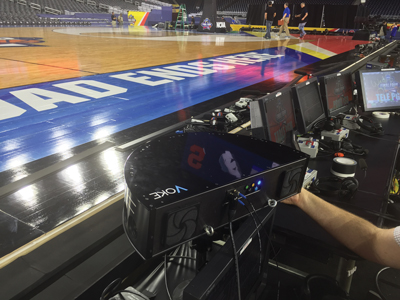 |
Companies such as Voke have focused primarily on live event production.
Photo by: Voke |
As a result of that, business dealmaking among virtual reality companies and sports entities is often based more on revenue-sharing agreements and other similar partnerships that share nascent advertising, subscription and sponsorship revenue as opposed to upfront payments.
“It’s extremely difficult to project the headcount for the virtual reality audience right now,” said Doug Perlman, founder and chief executive of Sports Media Advisors, which is working with NextVR. “That makes it very hard to do a traditional pro forma on a deal, and makes the partnership model much more attractive.”
Allen says he actually prefers such a model compared to a more traditional procurement process.
“We’re all about partnering with people,” he said. “We’re not a vendor or a production company for hire. I’m not just looking to be ‘hired.’ It’s all about working closely with somebody and collaborating to create truly compelling content.”
The buy side of virtual reality tells a similar story. The San Francisco Giants recently debuted a virtual reality experience at AT&T Park’s @Cafe in partnership with Jaunt. The club looked at a few potential partners on the project, but ultimately settled on the nearby Palo Alto, Calif.-based company.
“We have relationships with several of the folks there, particularly from their time before at Lucasfilm, and they really differentiated themselves in terms of their content,” said Bill Schlough, Giants senior vice president and chief information officer. “But it wasn’t a big, formal [review] process.”
Collegial environment
In any mature sector of the sports industry, there exists a distinct competitive spirit. Even if it’s a friendly competition, it’s still competition all the same. One TV network badly wants to outrate another in the same time slot. Leagues are all clamoring for largely the same base of potential fans. Sports apparel brands vigorously battle for market share.
Virtual reality is still a long way from that type of environment. Because the technology is so new, the installed base
of users is so small and the flow of programming so irregular, companies in the space typically view each other with a nodding respect.
“We’re both trying to build up the space,” said Voke CEO and President Sankar Jayaram, of the company’s lack of a rivalry with NextVR in live event production. “I want both of us to succeed. There’s definitely enough opportunity for the both of us.”
There have even been some early alliances between companies in the virtual reality business. Jaunt, whose expertise lies in more cinematic productions, late last year reached a production deal with Ryot, which has forged its own niche in documentary-style storytelling.
Other industry executives agreed that type of approach represents a smart strategy in virtual reality’s early days.
“It may make sense for us to do some cooperative business,” Mandt said. “Our big priority right now, more than anything else, is that we get the story right and the experience right.”
Recent VR highlights in sports
2014
March: The Sacramento Kings begin using the Oculus Rift headset to serve as a portable sales center for potential season-ticket, premium-seat and sponsorship customers for its new arena under construction.
2015
January: The NBA joins Samsung’s Milk VR streaming video service, contributing game highlights and behind-the-scenes video content.
March: Golden State Warriors co-owner Peter Guber watches a portion of the team’s home game against the Dallas Mavericks wearing a NextVR headset. The game is shot in VR and the footage is shared with the NBA office in New York but not shared with the public. Guber is an investor in NextVR and chairs the company’s advisory board.
March: Fox Sports and NextVR test the technology during NASCAR weekend at Auto Club Speedway in Fontana, Calif.
June: The Dallas Cowboys sign a two-year deal with Strivr Labs to train the team’s quarterbacks using a VR
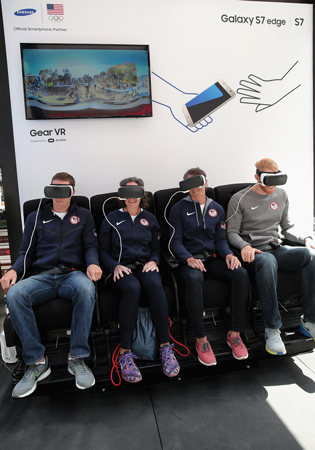 |
Samsung employed virtual reality at Team USA’s 100 Days Out event last month in New York City.
Photo by: Getty Images |
headset. Strivr’s client portfolio consists of football programs at Arkansas, Clemson, Vanderbilt, Auburn, Dartmouth and Stanford. Former Stanford kicker Derek Belch developed Strivr as a master’s thesis in the school’s VR lab.
June: NextVR and Fox offer live VR streaming of the U.S. Open to fans visiting select hospitality areas at Chambers Bay.
July: NextVR partners with the International Champions Cup to show the Manchester United-FC Barcelona match live, representing the first live VR broadcast of a major soccer match.
August: The Arizona Cardinals, New England Patriots, Minnesota Vikings and New York Jets begin using Strivr devices during training camp.
August: American Express partners with Maria Sharapova on a virtual reality experience, developed by HTC Vive, that lets U.S. Open fans return the tennis player’s serves.
September: Gatorade uses YouTube 360 to debut a VR video featuring a batter’s box perspective using the Washington Nationals’ Bryce Harper.
September: Disney and two other investors lead a $65 million investment into VR startup Jaunt.
October: The NBA, Turner Sports and NextVR produce a live VR game stream of the New Orleans Pelicans-Warriors season opener. The production does not include any graphics or announcer commentary but relies on the in-arena noise for audio.
October: The Sacramento Kings announce an investment in Voke and live-stream their home opener against the Los Angeles Clippers to select fans in VR.
October: MLS partners with NextVR for a VR test at the LA Galaxy and Portland Timbers match at StubHub Center. Viewers control their viewpoints using VR headsets.
November: Strivr signs the New York Rangers as a client. The Rangers launch a VR experience in the concourse at Madison Square Garden.
November: The Washington Redskins launch a VR experience at FedEx Field, sponsored by Anheuser-Busch.
December: “Striving for Greatness,” a five-episode online biopic featuring LeBron James preparing for his 13th NBA season, is shot entirely in VR with Oculus and airs on the “Uninterrupted” Facebook page.
December: NextVR signs an exclusive partnership to broadcast live coverage of this summer’s International Champions Cup, which will mark the first full-length VR broadcasts of an entire multi-event tournament.
2016
January: NextVR partners with Fox Sports to bring live coverage from Staples Center of the network’s Premier Boxing Champions telecast, marking the first boxing matches shown in VR.
January: At the Bridgestone NHL Winter Classic, VR production studio Jaunt captures footage from the game, player introductions, locker rooms and the atmosphere from the event. The NHL then showcases the footage for fans at the All-Star Game in Nashville in February.
January: Cleveland Cavaliers owner Dan Gilbert and ad agency WPP combine to contribute $35 million into a new investment fund that will target VR and other technologies.
February: NextVR and Fox Sports announce a five-year partnership for live coverage of events, including feeds from the Daytona 500.
February: U.S. Soccer unveils a new version of its red, white and blue crest using the Google Cardboard device for VR viewing.
February: Samsung VR live-streams the opening ceremony of the Winter Youth Olympic Games in Lillehammer, Norway.
March: NextVR and Fox Sports partner to provide a VR live-stream of the entire Big East basketball tournament.
March: Monumental Sports & Entertainment founder Ted Leonsis launches a $10 million venture capital fund to invest in tech startups. Monumental is already a partner with Strivr.
March: Voke closes on a $12.5 million Series A round of venture capital funding, led by Intel Capital (the investment arm of technology giant Intel), the Sacramento Kings (who already have equity in the company), cable network A&E and Nautilus Ventures.
April: The Tampa Bay Rays sign a deal with EON Sports to use VR for their batters to experience the pitchers they are about to face.
Source: SportsBusiness Journal research



